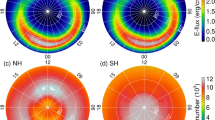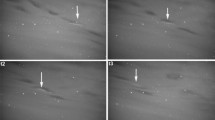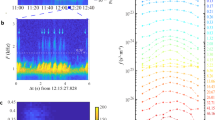Abstract
IT HAS long been assumed that aurorae, like stars, are present during daylight, but hidden by the high surface brightness of the sky. The brightest aurorae are discrete curtains of light created by beams of electrons accelerated in the Earth's magnetosphere. Many theories1 have been proposed to explain discrete aurorae, but the one that provides the best match to recent observations2 invokes a positive feedback mechanism between the conductivity of the ionosphere, which is enhanced by the injection of electrons, and the current carried by these same electrons3–5. Here we present a statistical study of electron precipitation events by using nine years of charged-particle data from weather satellites. We find that the beams of accelerated electrons that cause the discrete aurorae occur mainly in darkness: the winter hemisphere is favoured over the summer hemisphere, and night is favoured over day. We also find that discrete aurorae rarely occur in the presence of diffuse aurorae, which provide sufficient conductivity to support the electric currents between the magnetosphere and the ionosphere. Taken together, these observations strongly support the view that ionospheric conductivity is the key factor controlling the occurrence of discrete aurorae.
This is a preview of subscription content, access via your institution
Access options
Subscribe to this journal
Receive 51 print issues and online access
$199.00 per year
only $3.90 per issue
Buy this article
- Purchase on Springer Link
- Instant access to full article PDF
Prices may be subject to local taxes which are calculated during checkout
Similar content being viewed by others
References
Borovsky, J. E. J. geophys. Res. 98, 6101 (1993).
Newell, P. T., Lyons, K. M. & Meng, C.-l. J. geophys. Res. 101, 2599–2614 (1996).
Atkinson, G. J. geophys. Res. 75, 4746–4755 (1970).
Sato, T. J. geophys. Res. 83, 1042–1048 (1978).
Lysak, R. J. J. geophys. Res. 96, 1553–1568 (1991).
Evans, D. S. J. geophys. Res. 73, 2315–2323 (1968).
Rasmussen, C. E., Schunk, R. W. & Wickwar, V. B. J. geophys. Res. 93, 9831–9840 (1988).
Robinson, R. M., Vondrak, R. R., Miller, K., Dabbs, T. & Hardy, D. A. J. geophys. Res. 92, 2565–2569 (1987).
Iijima, T. & Potemra, T. A. J. geophys. Res. 83, 599–615 (1978).
Author information
Authors and Affiliations
Rights and permissions
About this article
Cite this article
Newell, P., Meng, CI. & Lyons, K. Suppression of discrete aurorae by sunlight. Nature 381, 766–767 (1996). https://doi.org/10.1038/381766a0
Received:
Accepted:
Issue Date:
DOI: https://doi.org/10.1038/381766a0
This article is cited by
-
Northern preference for terrestrial electromagnetic energy input from space weather
Nature Communications (2021)
-
Hemispheric asymmetry of the dayside aurora due to imbalanced solar insolation
Scientific Reports (2020)
-
Quiescent Discrete Auroral Arcs: A Review of Magnetospheric Generator Mechanisms
Space Science Reviews (2020)
-
Quiet, Discrete Auroral Arcs—Observations
Space Science Reviews (2020)
-
North-South Asymmetry in the Geographic Location of Auroral Substorms correlated with Ionospheric Effects
Scientific Reports (2018)
Comments
By submitting a comment you agree to abide by our Terms and Community Guidelines. If you find something abusive or that does not comply with our terms or guidelines please flag it as inappropriate.



